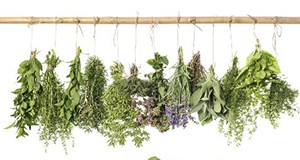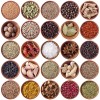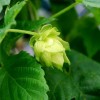 People worldwide are becoming more adventurous when cooking with fresh herbs. If you are just starting to use fresh herbs in your cooking or need a refresher, these tips for washing, storing, and cooking with herbs will lead you in the right direction. This 8-page fact sheet discusses the history of herbs, how to buy them fresh, how to wash and store them, dried herb blends, common herb and food combinations, and several recipes using herbs. Written by Emily Minton and Martha Maddox and published by the Department of Family, Youth, and Community Sciences, October 2015. (Photo credit: Credit: LiliGraphie/iStock/Thinkstock.com)
People worldwide are becoming more adventurous when cooking with fresh herbs. If you are just starting to use fresh herbs in your cooking or need a refresher, these tips for washing, storing, and cooking with herbs will lead you in the right direction. This 8-page fact sheet discusses the history of herbs, how to buy them fresh, how to wash and store them, dried herb blends, common herb and food combinations, and several recipes using herbs. Written by Emily Minton and Martha Maddox and published by the Department of Family, Youth, and Community Sciences, October 2015. (Photo credit: Credit: LiliGraphie/iStock/Thinkstock.com)
http://edis.ifas.ufl.edu/fy1209
Tag: Herbs
De compras para la salud: Las hierbas y las especias
 Las hierbas y las especias han sido usadas durante cientos de años en la cocina y en la medicina. Estas añaden una amplia gama de sabores a los alimentos y también pueden proporcionar beneficios para salud. Para algunas personas, el uso de hierbas y de especias en la cocina puede ser un reto—¡pero no tiene qué ser así! La siguiente información le permitirá estar en un buen camino para disfrutar de una sazón sabrosa y saludable.This 4-page fact sheet is the Spanish language version of Shopping for Health: Herbs and Spices, written by Jenna A. Norris and Wendy J. Dahl, and published by the UF Department of Food Science and Human Nutrition, January 2015.
Las hierbas y las especias han sido usadas durante cientos de años en la cocina y en la medicina. Estas añaden una amplia gama de sabores a los alimentos y también pueden proporcionar beneficios para salud. Para algunas personas, el uso de hierbas y de especias en la cocina puede ser un reto—¡pero no tiene qué ser así! La siguiente información le permitirá estar en un buen camino para disfrutar de una sazón sabrosa y saludable.This 4-page fact sheet is the Spanish language version of Shopping for Health: Herbs and Spices, written by Jenna A. Norris and Wendy J. Dahl, and published by the UF Department of Food Science and Human Nutrition, January 2015.
http://edis.ifas.ufl.edu/fs264
Florida Edible Garden Plants: Hops (Humulus lupulus)
 Hops are perennial, herbaceous climbing plants commonly cultivated for their strobiles or cones (Figure 1). The cones are often used for flavoring and aroma in food, tea, and beer (Burgess 1964). Hops can make a unique addition to a home garden or landscape. It grows rapidly in the early spring to late summer. Plants reach a mature height of 18–25 feet in one year and produce cones from mid-summer to early fall. This 2-page fact sheet was written by Brian J. Pearson, and published by the UF Department of Environmental Horticulture, October 2013.
Hops are perennial, herbaceous climbing plants commonly cultivated for their strobiles or cones (Figure 1). The cones are often used for flavoring and aroma in food, tea, and beer (Burgess 1964). Hops can make a unique addition to a home garden or landscape. It grows rapidly in the early spring to late summer. Plants reach a mature height of 18–25 feet in one year and produce cones from mid-summer to early fall. This 2-page fact sheet was written by Brian J. Pearson, and published by the UF Department of Environmental Horticulture, October 2013.
http://edis.ifas.ufl.edu/ep488
Shopping for Health: Herbs and Spices (FSHN1303/FS225)
 Herbs and spices have been used for hundreds of years in cooking and medicine. They add a wide range of flavors to food and may also provide health benefits. For some people, using herbs and spices in cooking may be a challenge, but it doesn’t have to be that way! The information below will get you on track to enjoying zesty, flavorful, healthy cooking.This 4-page fact sheet was written by Jenna A. Norris and Wendy Dahl, and published by the UF Department of Food Science and Human Nutrition, April 2013.
Herbs and spices have been used for hundreds of years in cooking and medicine. They add a wide range of flavors to food and may also provide health benefits. For some people, using herbs and spices in cooking may be a challenge, but it doesn’t have to be that way! The information below will get you on track to enjoying zesty, flavorful, healthy cooking.This 4-page fact sheet was written by Jenna A. Norris and Wendy Dahl, and published by the UF Department of Food Science and Human Nutrition, April 2013.
http://edis.ifas.ufl.edu/fs225
Distillation of Essential Oils (WEC310/UW355)
Essential oils are volatile, aromatic oils obtained from plants and used for fragrance, flavoring, and health and beauty applications. Learn about the history of essential oils, plant anatomy, and basics of essential oil distillation in this 4-page fact sheet was written by Elise V. Pearlstine, and published by the UF Department of Wildlife Ecology and Conservation, April 2011.
http://edis.ifas.ufl.edu/uw355
FCS8932/FY1209 Cooking with Fresh Herbs
FCS8932, a 6-page illustrated fact sheet by Emily Minton and Martha Maddox, provides tips for washing, storing, and cooking with herbs — with recipes for herb blends and for dishes using fresh herbs. Includes references. Published by the UF Department of Family, Youth and Community Sciences, November 2010.
http://edis.ifas.ufl.edu/fy1209